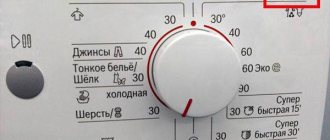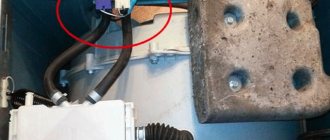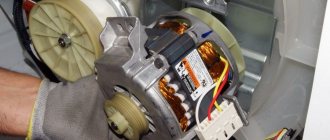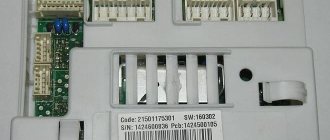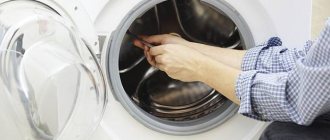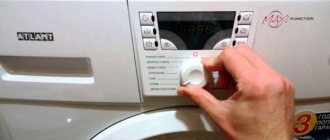Is your washing machine overheating the water? For colored linen, woolen, and cotton items, this can be a disaster: they fade and shrink. Each washing program provides a specific temperature: 30, 40, 60 degrees. Delicate items should be washed in the most gentle mode - no more than 40°C.
Why the machine overheats a lot and how to fix the problem, read our article.
ARDO WASHING MACHINE ON OUR WEBSITE. For free! The instructions can be downloaded or viewed online.
Replacing the heating element
Operating a washing machine with a faulty heating element will result in the programmer breaking down. To check the functionality of the device, you will need a multimeter (the regulator should be at 200 ohms). Then the wire connectors are removed. The resistance at the outputs should be in the range of 30-60 Ohms. If the multimeter needle remains motionless, then you will need to replace the heating element with a new analogue. This takes into account the model of the washing machine. In household appliances from different manufacturers, the heating element can be located in front, behind or on the side (in models with vertical load).
Before replacing the heating element, it is recommended to drain the water from the tank. To do this, you will need to unscrew the filter located in the lower right corner. Then the wires going to the heating element are disconnected. The fastening nut is unscrewed, the pin with the fastening element is pressed in. To perform the last process, use a flat-head screwdriver or knife.
The heating element is dismantled, the scale inside the tank is removed. Before installing a new device, you will need to descale the seat. The fixing nuts are tightened carefully. After installing the parts, the functionality of the new heating element and tightness are checked. The washing machine turns on in washing mode with a temperature of 60°C.
If the household appliance works normally, then the housing wall is attached. To extend the life of the heater, it is recommended to descale it. 100 g of citric acid is poured into the container for washing powder. The machine starts (without laundry) in washing mode with a temperature of 90°C. This procedure should be carried out once every 2-3 months.
Electric motor failure
The engine stops working for a variety of reasons. For example, due to the drum of an LG or Indesit washing machine being overloaded with clothes, a change in its power, worn out or “non-original” brushes. The panel heats up - this is why the motor becomes faulty.
If the washing machine engine is heating up, you can smell the wife's characteristic smell of rubber or plastic. Even if the wires do not burn, overheating can be easily checked by lightly touching the motor.
The engine is not repaired; usually it is immediately replaced with a new one. Don't wait until the washing machine starts smoking. In the event that the owner of a piece of equipment discovers that it is heating up, you should call a technician or, if you have the skills, carefully inspect the engine yourself.
Why else do LG or Bosch Max 4 devices overheat:
- short circuit in the control board;
- object hitting heater or motor;
- the contact of the tubular electric heater is burnt;
- short circuit;
- The thermostat has failed.
What to do?
The first step is to carefully inspect the washing machine and turn off the power by disconnecting the plug from the outlet. Now you need to determine the cause of the breakdown, without which the equipment cannot be repaired.
It’s better not to do this yourself, but to trust professionals in their field, especially when:
- the case gets very hot;
- heating temperature is very high;
- The glass of the washing machine is heating up.
After diagnosing, repairing or replacing a faulty part, the technical product will work as before.
Selecting parts yourself sometimes just means wasting money. A beginner cannot always figure out which material is best to choose a part from, which in the end simply won’t fit the machine.
If the washing machine is heating up, there is no need to wait until it smokes. There are many reasons why you may notice that the panel on top or the glass is heated. Any minor breakdown can completely disable the device.
Voltage fluctuations, long service life or low-quality parts can lead to overheating of the device and its rapid failure. Equipment for washing clothes is not an exception. If your washing machine is overheating, it is not always easy to determine the cause. Let's look at possible malfunctions and also talk about how to fix them.
How a washing machine works ↑
The washing machine knocks out the automatic machine.
Many housewives never tire of at least mentally thanking the creator of the automatic washing machine. There are many advantages, ranging from saving time to high quality of work performed. This is the very case when household appliances perfectly replace a person.
There are many models on the market, from simple functional mechanisms to complex devices with an electronic control system. However, the principle of operation is approximately the same for all:
- the laundry is placed in a special drum;
- the appropriate washing program is set;
- water is supplied to the machine;
- water is heated to the required temperature using a tubular electric heater;
- The drum rotates according to the specified washing, rinsing and spinning parameters.
Diagram of the washing machine
The operating cycle of the machine ranges from 30 minutes to 3 hours, provided that the laundry is pre-soaked and washed at a maximum temperature of 90°C. That is, this is practically digestion, familiar to everyone from childhood. The more intense and longer the most frequent washing programs, the higher the risk of premature failure of certain components.
Mass replacement of old Soviet cars with modern models began to occur in the mid-90s. The basic service life of the units is no more than 10 years. But our people manage to operate the equipment longer, squeezing the maximum out of it.
Therefore, pioneer specimens are not uncommon in bathrooms and kitchens. As a rule, these are products from the manufacturer, produced at the main production facilities. Their quality is higher, which explains their durability. However, what to do if an almost new car breaks down? And how to find the cause of the failure?
What determines the heating of the machine from the very beginning?
What can you do with a machine that starts to get very hot from the very beginning, even though it is completely clean and lubricated? Well, there are two options - either suffer and endure, or throw it away and buy a normal one.
Because the heating of the machine depends on the rationality of its design and the quality of the selected motor. And if any of this was initially done incorrectly, then the machine can only be remade.
Basic maintenance does not require much effort. And it is much cheaper than calling a specialist and purchasing spare parts on https://master-plus.com.ua/. Here we have collected the main reasons why a washing machine motor fails.
What should you pay attention to first?
Why is the washing machine not drawing water well?
You can make sure that the problem is caused precisely by a lack of warming up, and not by bad powder or clogged filters, by carefully touching the glass of the hatch: 15–20 minutes after the start of the program, it should be warm. If the hatch is cold, it is necessary to exclude factors not related to breakdowns, namely:
- Correct connection. When owners install the machine themselves, the problem of unauthorized outflow of water into the sewer often arises. To maintain the required water level in the tank, the machine is forced to start pumping, and the heating element does not have time to warm up the newly filled volumes to the required temperatures. Bringing the conditions for using the machine in accordance with the standards allows you to quickly get rid of these troubles.
- Correct selection of the washing program. Due to the user's carelessness or due to the complexity of setting the cycle parameters, the machine can start modes using cold water. Read the instructions and try washing your clothes on other modes.
If according to these two indicators everything is normal, the reasons why the washing machine does not heat the water during washing should be looked for inside the device. There are only a few of them: problems with the heating element, damage to temperature or water pressure sensors, as well as malfunctions in the control unit.
Scale on the water heating element and increased water hardness
Scale is one of the most common reasons why heating elements do not heat water well. Lime deposits are the result of washing with water containing high levels of calcium, magnesium and rust. Neither machines from famous brands, such as Bosch, Samsung, Electrolux, nor economy-segment models from Indesit, Candy, LG, Ardo, Zanussi or Beko are immune from such problems.
To prevent the heating element from becoming crusty, manufacturers recommend adding various softeners when washing. The efficiency of using these substances can be increased by using special polyphosphate, salt or magnetic filters installed in front of the injection hose. They effectively trap even small particles and prevent the electric heater from coming into contact with unwanted inclusions.
If a limescale crust has already formed on the heating element, it must be removed. Depending on the thickness of the layers, this can be done by washing with professional cleaners or by physically polishing the heater tube. Craftsmen have adapted to cleaning heating elements with citric acid, but this method has rather low efficiency.
Temperature sensor failure
Thermostat (water heating sensor) is a small element that, depending on the model of the washing machine, can be located inside the heating element or on the surface of the tank. If it is damaged, the system receives incorrect signals about the temperature in the drum and does not give the command to heat the water.
Checking the functionality of the thermostat:
- Remove the sensor from the machine body and measure its resistance using a multimeter
- Place the part in hot water and repeat the measurements
Significant differences in readings indicate normal operation of the device. If the data obtained is identical or very close, it is worth talking about a component failure. The thermostat cannot be repaired; it must be replaced with a new one.
Damage to the water level sensor
The role of the water level controller in the washing machine tank is performed by a pressure switch. If it malfunctions, the control unit does not receive a signal to stop the water intake process. At the same time, the drain valve is activated, and the excess gradually flows into the sewer. In such conditions, the water does not have time to warm up to the required temperatures. The problem is eliminated by installing a new pressure switch.
Failure of the heating element
The service life of an average heater is 3–5 years. When there are power surges, shorted contacts, or due to a manufacturing defect, it fails ahead of schedule. Checking the serviceability of the element involves ringing with a multimeter. No voltage? This means that the answer to the question why the washing machine does not heat the water can be considered found. The problem is solved by replacing the part.
Control unit failure
What to do if the heating element is working properly, the sensors are normal, but heating does not occur? The source of the problem should be looked for in the control unit. There are a lot of options for module breakdowns: microcracks on the tracks, contact desoldering, software failures - in total there are about a dozen probable problems that can only be identified through in-depth diagnostics using professional equipment. Depending on the severity of the damage, repairing a washing machine involves updating the thermal paste, soldering connecting wires, updating utilities, or replacing a programmer that cannot be repaired.
What to do if your car overheats in a traffic jam
When driving a car for a long time in a lower gear, the engine operates with increased power, which in itself leads to overheating. Add to this the lack of counter-flow of air necessary to cool the radiator. What to do? The main thing is not to panic. Short-term overheating is not terrible, but if you see that the car is not cooling down, it’s time to act.
Important - do not turn off the engine unless absolutely necessary. Exactly - without extreme. A stalled, overheated engine is an almost 100% guarantee of repair. It will take quite a long time to describe what is happening in the engine in this case (rotating the liners together with the crankshaft, when the engine is subsequently started - the least of the possible troubles), just take it on faith.
Important - do not think about pouring water on the engine or pouring cold water into the radiator. The result is the same - repair. Moreover, you can try so hard that you cannot do without replacing the block and cylinder head. Another “beauty” of cold water is microcracks inside the block. Finding and eliminating will be very, very difficult, if not impossible. The car has overheated - try to pull over to the side of the road. If it doesn’t work out, don’t panic and don’t pay attention to those around you – it’s important for you to save the engine.
Stop at idle, turn the heater on full, and wait. If after 5-10 minutes the situation does not improve, turn off the engine. It’s a good idea to open the hood; the main thing in a panic is not to forget to set the car’s parking brake.
The only reason to turn off the engine right away is clouds of steam coming from under the hood.
Most likely, the cooling pipe has burst, and further operation of the engine will only worsen the situation.
This is what it looks like, engine overheating, if you look closely. Now you know why the engine gets hot and how to deal with it.
Regardless of the model manufacturer, be it LG or Indesit, the washing machine may break down one day. There are different breakdowns, for example, the machine knocks out the plugs, does not heat the water, the device itself gets hot. In any such situation, the owner of the machine must prevent breakdown. Let's take a closer look at the reasons why the washing machine gets very hot.
Methods of protection against scale
10 reasons why the indesit washing machine does not drain water
The main enemy of the heating element is scale. Its occurrence is associated with the quality of the liquid in the water supply system. There are several ways to deal with scale:
- The chemical treatment method involves exposing the surface of the heating element and the washing machine tank to special solutions to remove scale. Treatment with acid solutions should be carried out three times a year, and it should be remembered that the tank is made of stainless metal or plastic.
- The use of a physical method involves the use of magnetic type converters. They are installed on a water pipe and serve to effectively destroy magnesium and calcium ions, which significantly increases the quality of water.
- The technological method is based on the use of washing modes with low water heat. It has been experimentally proven that at low temperatures, scale formation is significantly reduced.
What to do if your AEG washing machine overheats
If it gets very hot, check the functionality of the temperature sensor. Most often it is located at the very bottom at the base of the tank tank in the rear part. Disconnect from the wires and remove it from the machine. Use a tester to check its resistance. To do this, first immerse the element in hot water. If the resistance does not change or changes only slightly, then the thermostat is faulty.
If the wiring shorts and the machine heats up because of this, inspect it for places where insulation has boiled and burnt areas. Replace damaged wires. If the breakdown is difficult to detect or the electric motor of the washing machine gets hot, you will most likely have to contact a special service. Also, without special skills, you will not be able to repair a damaged microcircuit on your own.
How to understand that the machine does not heat water
If at the end of washing the laundry is cold, this does not mean that there was no heating. Yes, this doesn’t mean anything at all. The last rinse is done with cold water and the laundry should not be heated. Usually a symptom of a lack of heating is poorly washed laundry. Not everything is clear either. If you use low-quality detergents or if you set the “quick wash” mode for heavily soiled laundry, the result is unlikely to please you.
The most optimal and realistic way to check is to feel the glass of the hatch during the first 30-40 minutes of washing. If it’s cold all the time, it really doesn’t heat. We can only remind you that during such a check the temperature must be set to at least 60⁰C.
Check if you are setting the washing programs correctly. After all, almost all automatic washing machines have cold water washing modes. It's likely that you (or someone close to you) accidentally turned off the heat on your car's control panel.
If in such cases you contact the service, they will be happy to “repair” your working washing machine and charge you money for the supposedly complex repair. Is the heating still not working? Then you'll have to figure out what to do with it next.
Why can’t heating up the machine be completely avoided?
No matter how elegant and precise your machine is, don’t forget that it has an electric motor inside. And, if you have a good car, this motor is quite powerful. For example, Mustang clippers produce 5,900 rpm. That is approximately 98 revolutions per second! Yes, yes, this is the very time you need to say “one”.
The knives move at incredible speed. Naturally, they heat up - even with good lubrication, the friction force still remains. And the engine itself, which produces such power, gets hot. This cannot be avoided except by turning off the machine.
But. This does not mean that the machine in your hands has the right to turn into a switched-on iron. The design of the machine must be such that the generated heat is distributed and does not cause discomfort during operation. And if the machine starts to heat up indecently, it means that either the design was not reasonable enough from the start, or something happened to the machine.
Causes
There are various circumstances that lead to problems with the washing machine. We'll have to figure out what exactly we're dealing with. You need to consider each reason and try to determine which element failed.
Main types of breakdowns:
- The heating element does not heat the water to the required temperature. This device works on the same principle as a boiler. On average, it lasts from 5 to 10 years. The duration depends on how often the washing machine is used. This part cannot be repaired; it must be replaced.
- The temperature sensor is not working. It is he who activates and deactivates the heating element. If the element does not function properly, then heating will not occur.
- The pressure sensor in the tank area is faulty. If it does not send a signal to the ECU that the tank is filled with water, then the heating will not turn on.
- No voltage is supplied to the heating element. This most often happens if the cable chain breaks.
- Failure in the control module assembly.
It’s worth taking a closer look at how to troubleshoot an LG washing machine. If you have no experience in repairs, then it is better to immediately call a specialist. He will diagnose and quickly fix the problem. You can try to repair the washing machine yourself, following the instructions.
Scale has formed on the heating element
Even if the heating element is working, it may also not perform its tasks. The problem lies in hard water, which contains a lot of magnesium and calcium. Because of this, scale appears on the heating element, and the water does not heat up. Thermal insulation leads to the heating element constantly overheating. As a result, it fails.
This problem is quickly resolved. To do this, you need to use one of the products that is used to clean the heating part. The correct solution would be to pour approximately 100 g of citric acid into the powder tray. There is no need to put laundry in the drum, and the wash should be started in this form. You will have to select the 60 degrees Celsius mode, and the time should be about 1.5 hours. As a rule, this is enough to remove scale.
The wiring is broken
If the water stops heating, then we can assume a break in the wiring that goes to the heating element. To understand what you are dealing with, you will have to inspect the wiring inside the SMA. If the wires are frayed, then they will need to be soldered and insulated. It also happens that the problem is not detected. In this case, the wiring will be fine, but the control unit will fail.
The heating element does not work
When the water does not heat up during washing, you will have to check if there are problems with the heating element. To do this, use a multimeter. With its help you can understand what problem you are dealing with.
What to do:
- Unplug the machine.
- Remove the back cover of the SMA.
- Find the heating element, which is most often located under the drum.
- Remove the wires connected to the heater.
- Measure the resistance with a multimeter, which should be from 24 to 40 ohms.
In the event of a malfunction, an open circuit will be indicated. The burnt part will need to be replaced with a working part. To do this, you need to remove the fastening nut and remove the heater. After this, a new element is installed, a wire is connected to it and washing is carried out for testing. You need to make sure that the rubber gasket does not leak and that the water heats up.
The electronic control unit is faulty
Sometimes it malfunctions, which causes a lot of problems. We have to flash the microcircuits and carry out reprogramming. It happens that a malfunction occurs due to broken or oxidized contacts. Such problems can only be determined by a master, because they are difficult for an ordinary person to identify.
Problems with the temperature sensor
Although LG machines are characterized by stable operation, their temperature sensor may break. It is he who controls what the temperature in the tank should be. If the LG washing machine does not heat the liquid at all or does not reach the desired mode, it can be assumed that there is a problem with the sensor. Using a multimeter you can see if it is working.
Instructions:
It is necessary to remove the CM housing cover. You will have to disconnect the wires from the sensor. The thermistor must be carefully removed and replaced with a new one. Connect the wires to the sensor.
If you do everything correctly, then the problem will disappear. The main thing is to find out why the LG machine does not heat the water, and what to do in a particular case. If you cannot cope with the task yourself, you should contact a specialist.
Reasons that can cause overheating
1. Lack of coolant. The liquid in the engine boils not because there is not enough of it, but here’s why: remember about the outer surface for cooling? If there is a lack of fluid, the contact surface between the fluid and the heated engine is insufficient, and heat transfer to the environment is poor. This is where the overheating comes from. The engine cooling system is not sealed, as many believe, and fluid evaporates during operation - do not forget to check its level regularly. And of course, monitor the condition of the radiator and pipes - leaks are unacceptable. There are cases of internal leakage - as a result of damage to the gasket between the head and the cylinder block. Water will not flow out of the exhaust pipe, but a constant decrease in the fluid level without visible leaks is a reason to be wary and contact a specialist. Water accumulated in the cylinders at the moment of starting the engine can lead to water hammer - this can literally destroy the piston group, and not only that.
2. Radiator condition. The gaps between the radiator honeycombs are quite small and can gradually become contaminated by representatives of the insect world. This is not a joke; there was a case when minor contamination of the radiator (coupled with the poor condition of the engine) led to constant overheating of the car. Keep the radiator clean and blow it with compressed air at least occasionally.
3. Incorrectly set ignition angle. If the ignition angle is violated, the fuel combustion process is disrupted. As a consequence, an increase in combustion temperature and a decrease in power. The power has dropped, but there is no need. What are we doing? That's right - press the gas pedal harder. It turns out that more fuel is spent on the design operating mode of the engine (at which normal cooling occurs). Hence the overheating. By the way, an ignition problem can arise (spontaneously, and not after your intervention in the finely tuned engine mechanism) if the timing belt or chain is stretched. This is not the only possibility, but it is common - keep in mind.
4. Fuel quality. An inappropriate octane number leads to a decrease in power and an increase in the temperature of fuel combustion. There is only one way out - refuel in one place, so the likelihood of getting bad gasoline is lower.
5. Deposits on the walls of the engine and radiator. The reason is simple - the use of low-quality coolant, or even water. A little more detail. From a physics point of view, using water is better, since water has better thermal conductivity than alcohol-containing antifreeze. But - there are salts in the water (you can see them on the walls of the kettle) - the same thing happens inside the engine. As a result, water circulation is disrupted, cooling efficiency is reduced and the engine overheats. If you are pouring water into the expansion tank, pour distilled water, it is free of salts. It is best to use special antifreeze. Believe me, it is impossible to completely remove scale from the engine. And one more “beauty of water: if, after water, for example in winter, you fill in antifreeze - be prepared for drips (it can leak anywhere: radiator, pipes) - this is a fact. If you constantly drive “on antifreeze,” nothing will happen, but after water, antifreeze will flow 99%.
6. Engine wear. This can include many aspects, but in most cases it is wear of the piston group. During long-term use of the car, the piston rings, which serve to seal the combustion chamber, wear out, which leads to a decrease in compression, impaired fuel combustion, loss of power (remember the formula) and overheating of the car.
Somehow it turned out to be too difficult. To put it simply: fuel burns better at a certain pressure that is created in the combustion chamber. Pressure is about 12 atmospheres. If you take a pipe, plug it with potatoes and blow inside, pressure will be created inside, which is called compression. The force with which you blow will represent the force of expansion of the fuel during combustion, which pushes on the piston and causes the crankshaft to rotate. The rings serve to fit the piston more tightly to the cylinder (in our case, potatoes and tube). Now, if you put in a loose piece of potato and blow, the air will pass past the potato piston.
This is what happens in the engine when the piston group wears out (ring wear and cylinder wall wear). As a result, part of the expansion energy of the fuel during combustion passes by the piston (between the piston and the cylinder), and compression (optimal pressure in the combustion chamber) decreases, which worsens the quality of combustion. And again - loss of power and overheating. There is only one way out - contact a specialist.
7. Radiator fan. In some (older) car models, there was no such reason, since the fan was driven directly from the crankshaft through a belt. Now, the fans are electric and turn on when the temperature sensor is triggered. The sensor may not work, and the fan may not turn on. This is a fairly common reason. You just have to go out and look - the motor connection contacts may be oxidized.
8. Air pockets formed when filling liquid. By the way, in this case the temperature sensor may not show an increase in temperature. How to get rid of a traffic jam is the topic of a separate article. I’ll add on my own – when pouring liquid into the cooling system, the car must be horizontal.
9. Thermostat. The thermostat divides the cooling system into two circles - small and large. The small one is used to warm up the car (the amount of liquid is reduced, the radiator is turned off), when a certain temperature is reached, the large circle is connected (the radiator is connected). If the thermostat is jammed, then only the small circle is used: the amount of fluid is insufficient, the radiator is turned off - the car is overheating. You can determine this by feeling the lower pipes leading to the radiator: if they are cold and the car is overheated, change the thermostat.
10. Pump. A pump is a pump that forcibly displaces water to improve circulation. By and large, two troubles can happen to the pump: it will simply leak - you will see, and the second, which is more difficult to determine, is wear of the pump impeller. When the impeller wears out, the pump slowly pumps liquid, as a result, the liquid in the engine heats up faster than in the radiator (water circulation worsens). You can tell by uneven heating - the radiator is cold, but the engine is boiling. Attention - the same symptoms occur if the thermostat is malfunctioning or if there is an air lock.
There may also be other reasons - one of which is from the category “you can’t invent it on purpose.” For example, the parking brake is not fully weakened, which leads to the car slowing down, increasing the load on the engine, and overheating. The handbrake cable may get stuck - there was such a case. The car slows down slightly, but this is enough in the heat.
And some people also blame the air conditioner on. By and large, this is rather a far-fetched reason. Of course, the air conditioner creates additional load on the engine, but this was taken into account during the development. If the engine is really bad - complete wear and tear - then this can happen. What to do - turn off the miracle of modern automobile manufacturing.
Perhaps we'll stop there. The only thing we'll talk about at the end is overheating in a traffic jam. No one is immune from this.
Why the machine may not heat water
Some modern models of washing machines are equipped with a self-diagnosis function. If the program detects a malfunction, the equipment stops functioning. But more responsible “brothers” can continue to carry out the given program, only using cold water. However, this does not mean that the problem does not need to be fixed. The most common reasons for equipment not working correctly are:
- Scale on the heating element. It is the heating element that is responsible for direct heating. During operation, its surface is gradually covered with a coating of lime. The situation is aggravated by the use of hard water. Accumulated deposits interfere with the normal functioning of the element and heating of the water. In addition, the heater constantly overheats. Over time, this leads to its breakdown.
- Heating element malfunction. To check the performance of the heating element, you will need a multimeter. If the element is functioning normally, the device will display a voltage of 25 to 40 ohms. Otherwise, the multimeter will display an open circuit. Then a replacement will be required.
- Broken wiring. The likelihood of this situation occurring is quite low. But a characteristic feature of all “washing machines” is constant vibration during operation. Because of this, a break in the electrical circuit going to the heating element may occur. Usually the location of the wire break is visible to the naked eye. You just need to remove the back wall of the washing machine and carefully inspect the cables.
- Damage to the control unit. The electronic control unit is the “brain” of the machine. He is the one responsible for the programs and algorithm of work. For this purpose, it is equipped with special memory chips - ROM. In certain situations, for example, a power surge, the microcircuit may stop functioning, and the memory of the washer may malfunction.
- The temperature sensor is broken. A thermostat is necessary to regulate the temperature of the water in the drum. Each washing program requires its own temperature regime, which is recorded in the electronic memory of the equipment. If the thermostat breaks down, the SMA may either not heat the water at all or bring it to 100 degrees. In modern machines, the sensor is located in the control panel or next to the heating element. To check its performance, use a multimeter.
- The pressure switch has failed. This is a sensor responsible for measuring the amount of water in the machine’s tank. To do this, he determines the pressure created by the water using a tube that is connected to the membrane of the element. During operation, the tube may become clogged with dirt, small debris, and pet hair. To check this, remove the top cover of the machine; usually the pressure switch is located under it on one of the walls.
Does it heat or not: methods of determination
The washing machine heater is checked for functionality in several ways. At the same time, there is no need to open the case and look for many tools - a timer and a free hand are enough to carry out the procedure. The easiest way to test the heating element is as follows:
- load some laundry into the drum so as not to wash empty;
- select the “Cotton” mode or another program with a set temperature of 60-90 degrees;
- press the “Start” button;
- wait 15-20 minutes;
- Place your palm against the glass of the hatch door.
Modern machines can independently diagnose the system for breakdowns and display the corresponding error on the display (for example, H1, H2, NOT, HC, E5, E6).
If your hand feels warm, it means the heating element has heated the water. But an icy door does not always indicate problems with the heater. It is likely that the time was calculated incorrectly; the machine has already switched to rinse mode and is drawing cold water from the water supply . It is better to repeat the check and have time to apply your palm at the washing stage. There are other methods for testing heating elements.
- Feel the top cover of the case, which also heats up noticeably 15-20 minutes after washing at 60 degrees. Suitable for both front and vertical machines. This is especially true in the latest machines, since the first method does not work due to the missing glass door.
- Touch the drain hose while draining waste water. Here you will have to be patient and wait to accurately determine the moment of draining. Then all that remains is to take the hose in your hand and feel whether its walls are heated. There is a more indicative alternative: loosen the clamp on the drain pipe, drain the water into the bathtub or sink and measure its temperature.
- Pay attention to the electric brush. 7-10 minutes after starting the cycle, the washing machine will begin to intensively consume energy due to the activation of the heating element, which will be indicated by a flashing light on the meter. The main thing is to turn off all other household electrical appliances during the test to eliminate “interference.”
Reasons why the washing machine does not heat the water
A washing unit is a complex household device consisting of many elements. The reason for the lack of water heating may be a malfunction or breakdown of:
- heating element (heating element);
- water heating sensor (thermostat);
- programmer (electronic unit);
- water level sensor in the tank (pressostat).
Also, the water may not heat up enough when:
- incorrect connection of the washing unit to the drainage system, resulting in self-draining of heated water caused by the siphon effect;
- incorrect choice of washing program, in which the selected mode in favor of a higher temperature mode is ignored.
Diagnosis of the problem
If the washing machine cannot heat the water, then you need to diagnose those spare parts whose failure prevents the water from heating. Diagnostics includes a visual inspection or the following actions aimed at identifying the problem:
- Inspect the water level sensor tube.
- Visual inspection of internal wiring.
- Visual inspection of the heating element for the presence of scale.
- Checking the performance of the heating element using a multimeter (measure the resistance of the device, heat the heating element and measure the resistance again, compare the indicators, and if they are almost the same, then the element has burned out).
- Checking the temperature sensor (check the operation of the machine with forced heating, if such a function is available).
Let's test the heating element
When there are problems with heating water, the first suspicion always falls on the heating element. This is logical, so it is recommended to start diagnostics with it. To get to the heater, you need to disconnect the washing machine from the power supply and water supply, move it away from the wall and turn the back panel forward. Next, unscrew the screws holding the “back”, remove it and look for the element. It is located in the lower part of the body directly under the drum.
Having removed the panel, it is easy to find the round “chip” of the heating element, as well as the thermistor and the wiring connected to them. However, you will first have to remove the drive belt from the pulley to ensure free access to the heater. Afterwards we photograph the location of all connections and proceed to diagnostics:
- disconnect the connected wiring;
- switch the multimeter to the “Resistance” mode and set it to “200 Ohm”;
- We bring the probes to the terminals of the heating element;
- We evaluate the indicators.
A working heating element displays a value of at least 26 Ohms, maximum - 28 Ohms. If the device outputs “1” instead of the norm, then the heater was damaged due to an internal winding break. A result of “0” will indicate a short circuit has occurred. In the extreme two cases, it will not be possible to repair the element - replacement is necessary.
The next step is to check the housing for breakdown. We switch the tester to buzzer mode and apply the probes. If a squeak is heard upon contact, it means that a current leak has been detected - you will have to change the heating element.
The heating element is easy to change. It is enough to dismantle the old device by loosening the central nut and disconnecting the thermistor. Difficulties arise when the existing rubber gasket becomes deformed, increases in size and “blocks” the heater. In this case it is necessary:
- generously lubricate the cuff with WD-40;
- wait 15-20 minutes;
- collect remaining lubricant;
- swing the heater and pull it out of its seat.
When replacing, it is important to choose the right analogue. The main reference point will be the markings stamped on the heater body. The serial number of your existing Atlanta will also help.
It’s even better to bring the dismantled heating element to the store and find a replacement on the spot. Before installing a new heater, it is recommended to thoroughly clean the seat from dirt and scale. The machine is assembled according to the instructions described earlier, only in reverse order.
The serial number of your existing Atlanta will also help. It’s even better to bring the dismantled heating element to the store and find a replacement on the spot. Before installing a new heater, it is recommended to thoroughly clean the seat from dirt and scale. The machine is assembled according to the instructions described earlier, only in reverse order.
Does it heat or not: methods of determination
The washing machine heater is checked for functionality in several ways. At the same time, there is no need to open the case and look for many tools - a timer and a free hand are enough to carry out the procedure. The easiest way to test the heating element is as follows:
- load some laundry into the drum so as not to wash empty;
- select the “Cotton” mode or another program with a set temperature of 60-90 degrees;
- press the “Start” button;
- wait 15-20 minutes;
- Place your palm against the glass of the hatch door.
Modern machines can independently diagnose the system for breakdowns and display the corresponding error on the display (for example, H1, H2, NOT, HC, E5, E6).
If your hand feels warm, it means the heating element has heated the water. But an icy door does not always indicate problems with the heater. It is likely that the time was calculated incorrectly; the machine has already switched to rinse mode and is drawing cold water from the water supply . It is better to repeat the check and have time to apply your palm at the washing stage. There are other methods for testing heating elements.
- Feel the top cover of the case, which also heats up noticeably 15-20 minutes after washing at 60 degrees. Suitable for both front and vertical machines. This is especially true in the latest machines, since the first method does not work due to the missing glass door.
- Touch the drain hose while draining waste water. Here you will have to be patient and wait to accurately determine the moment of draining. Then all that remains is to take the hose in your hand and feel whether its walls are heated. There is a more indicative alternative: loosen the clamp on the drain pipe, drain the water into the bathtub or sink and measure its temperature.
- Pay attention to the electric brush. 7-10 minutes after starting the cycle, the washing machine will begin to intensively consume energy due to the activation of the heating element, which will be indicated by a flashing light on the meter. The main thing is to turn off all other household electrical appliances during the test to eliminate “interference.”
Cleaning or replacing the heating element
Initially, you need to get to the location of the heating element (see the instructions for your model). There is no need to remove it immediately - it is quite possible that it is working, and the water in the LG or another brand of washing machine is not heating for a completely different reason. How to check the functionality of the heating element:
- a multimeter is used for this;
- one tester probe is attached to the body of the machine, and the other to the heating element itself;
- in the working heating element the resistance will be zero, while on the body it will be about 30-60 Ohms;
- if the probe arrow on the body remains motionless, it means that the heating element is faulty - there is a hole in the spiral.
This element will need to be replaced. First you need to drain the water from the tank, for which the filter at the bottom of the device is unscrewed and removed. Next, you need to remove the wires connected to the heating element, unscrew the fastening nuts and press in the fastening pin. All this can be done with a flathead screwdriver or a regular kitchen knife.
After removing the heating device, you need to thoroughly clean the tank and seat from scale. To do this, you can use appropriate household chemicals. After this, a new heating element is installed
Particular attention is paid to the strength of the fastening. After installation is completed, the cover is attached, the device is checked for leaks and only then for operability.
Cleaning the heating element
The heating element does not always need to be replaced. Sometimes you can just clean it. If the water still heats up, but does so very slowly, it is quite possible that scale is interfering with the normal process. For cleaning, you will also need to remove the heating element using the method described above. If there is a lot of plaque, you can try to scrape it off with a sharp object - the same knife, for example. Remaining plaque is removed with chemicals or citric acid. After this, the machine is assembled in the reverse order.
Why does the machine start to get very hot during operation?
The number one reason that accounts for most of the situations when an initially normally working machine begins to overheat is contamination. Hair clippings, deposited sebum, dust - all this increases friction when moving the knives. Accordingly, the system heats up more.
Thus, the first thing to do if the machine starts to heat up is to clean it. This is a subtle matter, but quite real. We wrote about this, it’s better not to repeat it.
So, the machine needs to be cleaned, lubricated, and then examined - and, if nothing has changed, take it to the service center and ask the technician what else could have happened to it.
This, of course, applies to cases when the machine initially worked normally and did not get particularly hot - and then suddenly began to heat up somehow suspiciously. Because many cars start to heat up from the very beginning - fiercely and inconveniently. What to do with such machines?
Malfunctions
There may be several faults in this situation.
Level sensor faulty
Quite often, in some washing machines, the level sensor tube may become clogged. This happens when washing. Hair, threads or some pieces of fabric may get into it. Such blockages make it difficult for this part of the machine to operate normally. That is, water is poured into the tank. But the heating element does not work. And all because the module is misinformed and does not issue a command for heating.
In order to fix this, you can clean the tube or replace the sensor. You can learn how to make this replacement yourself from the video:
Heating element (heating element) open circuit
Another possible breakdown is a break in the heating element circuit. In order to check the condition of the circuit, you need to ensure the integrity of the wires that are adjacent to the heating element. In a number of washing machine models, the wires leading to the heating element are located next to the machine body. Such an arrangement may negatively affect their safety. During washing, spinning and other operations, the machine produces vibrations. And the wiring may simply fray. If you discover this malfunction, you must either solder the broken wires or replace them with new ones.
The most common breakdown that causes a lack of heating of water in a washing machine is the failure of the heating element itself. In order to check the serviceability of this part, it is better for us to use a tester. By ringing the heating element we can determine whether it is working or not. If we are convinced that the reason for the incorrect operation of the machine is in the heating element, then it should be replaced with a new one. The replacement process is quite simple. A person without special skills can handle it. To carry out the entire operation, you only need to remove the back cover of the washing machine. Then, loosen the fastenings of the part, remove it and install a new one. You can learn how this is done from the following video:
You must be careful when removing and replacing this part. Since too sharp removal and incorrect installation can damage the plastic tank.
When purchasing a new heating element, you need to be very careful. After all, an unsuitable part may not fit in the place of the old one, interfere with normal operation, or even break your household appliance. In order to find a new heating element, we recommend using the Internet. This is the easiest way to find and order the necessary spare part in your city.
Scale or increased water hardness
Scale on the heating element of a washing machine can occur due to a high concentration of magnesium and calcium salts or rust in tap water. The appearance of scale can affect the heating of water. Since it worsens the functions of the heating element. In order to avoid such troubles, you can use special tools to keep the machine in good condition. For example, colgon. Or install a filter that will soften the water.
Heating sensor failure
It must inform the control module about the moment when it is necessary to activate the heating device. And if it stops working, then it needs to be changed. To do this, watch the video instructions:
Debugg
After identifying a malfunction resulting in the washing machine not heating the water, you need to fix it. You can do this as follows:
- Clean or replace the water level sensor tube.
- Replace or solder and insulate damaged wires.
- Remove scale from the heating element by boiling it in water with citric acid.
- Replace the heating element with a new one.
- Replace the temperature sensor.
- Replace or repair the control module.
It is better to entrust the replacement of the control module to professionals, and in some cases simply purchase a new device, since the replacement procedure can be more expensive.
If the water in the washing machine does not heat up, you need to find the cause of the equipment malfunction and try to eliminate it. If difficulties arise, it is better to contact a repairman. And if the washing machine is under warranty, then contacting the service center is mandatory without attempting to fix the problem yourself.
Short circuit between instrument panel and engine
Burnt contacts and a short circuit in the dashboard lead to uncontrolled operation of the washing machine and its overheating. Failure can be diagnosed by a number of signs:
- When the machine is turned on, the panel indicators do not light up or periodically turn on and off (blink);
- The panel gets very hot;
- You can smell the smell of melted plastic.
If a short circuit occurs in the motor winding, the machine stops working - the drum stops, possibly sparking, noise, or a burning smell.
For an accurate diagnosis, it is necessary to visually inspect the motor and instrument panel, and also check for the presence of voltage with a tester in ohmmeter mode. In order to examine the dashboard, you need to remove the top cover, which is attached to two self-tapping screws. Visually detect burnt contacts and measure their resistance.
To diagnose the motor, it is necessary to dismantle the rear wall (for free access in some models, you also need to remove the side wall).
After dismantling the engine, you need to check:
- Winding;
- Brushes;
- Lamels.
Damage to any structural part of the motor can cause the washing machine to overheat.
The main cause of heating is the incompatibility of the plug and socket. You should not try to push a new-style plug into a Soviet socket, since the contact is incomplete and strong heating occurs. You should not connect many high-power devices to one outlet. The maximum permissible power is always indicated on the sockets.
Is your washing machine overheating the water? For colored linen, woolen, and cotton items, this can be a disaster: they fade and shrink. Each washing program provides a specific temperature: 30, 40, 60 degrees. Delicate items should be washed in the most gentle mode - no more than 40°C.
Why the machine overheats a lot and how to fix the problem, read our article.
When the tank is unloaded, you can begin diagnostics. To do this, it is important to understand the heating principle in the washing machine of Bosch, Siemens, Electrolux and other brands.
How is water heated in the SMA?
As soon as the tank is full, the machine starts heating:
- The control board sends a signal to the heating element to start working.
- As soon as the temperature reaches a predetermined level, the thermistor reports this to the module.
- The control element gives the heating element a command to stop working.
If one of the three parts breaks or their operation malfunctions, the washing machine begins to boil water. An additional reason could be burnt out wiring.
Contact the professionals
If your machine is faulty, contact a professional. Our specialists have been repairing for many years and are aware of the weak points of AEG models and machines from other manufacturers. We will accurately determine the breakdown and fix it quickly. Our range of services includes:
- free diagnosis of the cause of the breakdown;
- repair or replacement of a failed component;
- preventing the problem from reoccurring;
- providing a guarantee for any repairs.
Modern washing machines have dozens of wash programs. Each of them involves heating water to a certain temperature, on average from 30? up to 95?.
Delicate items are washed in cold water, and to remove particularly difficult stains, the water temperature is set to the highest possible temperature.
When washing at maximum temperature (90-95?), the water in the washing machine gets very hot. This happens gradually and only 10-15 minutes after starting the wash.
If you carefully touch the glass of the hatch in the middle of the cycle, you can understand how hot the water is inside.
Heating the temperature of the water in the tank to 100? when it boils
and literally melts the entire unit, indicating a malfunction of one of its important parts.
The washing machine usually begins to overheat and even boil the water in the drum after many years of service due to
wear of parts and frequent power surges.
The exception is a manufacturing defect. In this case, the new equipment gets very hot.
There are several ways to find out that the machine is overheating the water:
- If the water overheating is insignificant
(10-20? higher than it should be) - according to the condition of the laundry after washing. Things fade, shrink, become deformed. - If the overheating is significant
(the water is boiling), the washing machine heats up completely: its body heats up, the air nearby becomes hot, and steam may come out of the top cover.
To understand the reasons for water overheating, you need to understand the principle of its normal operation.
for heating the water in the washing machine :
- The control board
(electronic module or programmer) is the “brain” and mini-computer of the machine, which sends signals about heating/stopping water heating to the heating element (heating element) and receives a signal about the water temperature from the device that measures it (thermostat or thermistor). - Heating element relay.
Disables the heating process of the electric heater. - Thermistor
(if the unit is electronically controlled) or
thermostat
(if the control is electromechanical). These sensors measure the temperature of the water in the washing machine and determine the moment when it has reached a set value; after which the thermistor transmits data to the electronic module, and the thermostat itself turns off the heating element relay.
The heating element heats the water, the temperature sensor measures it, and the control board regulates these processes.
Accordingly, the machine can overheat the water if one of these parts breaks:
- The control board is malfunctioning. You need to reflash it or replace it with a new one.
- Malfunction of the thermistor or its “burnout”. It is necessary to either clean the unit from scale (the thermistor is also susceptible to scale!) or replace the thermistor with a new one. The thermostat can only be replaced with a new one.
- The heating element relay “sticks”. The relay needs to be replaced.
Also, overheating of water in the washing unit can be caused by:
- burnout of internal electrical wiring,
- breakdown of the electric motor.
Repairs of this kind, as well as reinstallation of parts, should only be performed by an experienced and certified technician. Otherwise, the problem of overheating water in the washing machine can result in even greater difficulties and final breakdown of the unit.
Call a VseRemont24 specialist to your home! Diagnostics will show what exactly caused the malfunction, after which a specialist will promptly repair the washing machine.
It is important for the owner of a washing machine that gets very hot to remember safety measures.
If the body of the unit becomes extremely hot during washing, and especially if there are clouds of steam, you need to:
- Stop washing by pressing the “On/Off” button.
- Switch the mode to “Drain”.
- After the machine has drained the water, turn it off and disconnect it from the power supply.
- After giving the machine some time to cool down, remove the laundry from the drum.
If you have the time, effort, knowledge, and tools, you can check the functionality of the water temperature sensor.
Its failure is
the most common
cause of overheating of a washing machine.
To get to the thermostat
, required:
- Disassemble the back of the machine.
- Find the heating element and identify the temperature sensor. They are located at the bottom of the tank at the rear wall.
- Disconnect the wire contacts, loosen the central nut and remove the sensor.
For check
Temperature sensor will require a special device - a tester that measures resistance.
Verification steps:
- Resistance measurement at room temperature.
- Measuring the resistance of a sensor previously lowered and heated in hot water.
The tester readings should significantly
vary. Otherwise, the water temperature sensor is faulty.
Overheating of the washing machine body or its individual components can be caused by various factors. It all depends on which parts are overheating. Most often this is:
- Washing machine body
- Plug and socket through which the unit is powered
- Dashboard
- Engine
Diagnosing the cause of overheating is not as easy as it might seem at first glance. To do this, you will need a special device - a tester. Using the tester, you can determine the voltage strength of individual nodes.
If you notice that the machine is overheating, you must stop washing immediately. Overheating can cause damage to the entire device. You should not try to find out the cause of overheating and eliminate it on your own. Contact our service center, our technicians will be able to help you understand the causes of overheating and eliminate them.
Causes and symptoms of washing machine malfunction
The washing machine usually begins to overheat and even boil the water in the drum after many years of service due to wear and tear of parts and frequent power surges.
The exception is a manufacturing defect. In this case, the new equipment gets very hot.
There are several ways to find out that the machine is overheating the water:
- If the water overheating is insignificant (10-20? higher than it should be) - according to the condition of the laundry after washing. Things fade, shrink, become deformed.
- If the overheating is significant (the water is boiling), the washing machine heats up completely: its body heats up, the air nearby becomes hot, and steam may come out of the top cover.
To understand the reasons for water overheating, you need to understand the principle of its normal operation.
Diagnostics of heating element
Failure of the heating element is the most common reason that the water in the washing machine does not heat up. Under normal conditions, the heating element is designed for a long period of operation, 5 - five or more years. However, hard water, low-quality detergents or failure to comply with the operating conditions of the washing unit lead to the formation of scale on the heating element. As a result of this, the heat transfer process is disrupted, the heating element overheats and burns out.
Electric heating elements are used in many household appliances: kettles, pressure cookers, boilers, etc. They can be dry or wet type. Dry heating elements do not come into direct contact with water or other liquid. Washing units from most manufacturers use wet heating elements. Korean washing machines Samsung and LG, Italian Ariston or German Bosch are all equipped with similar heating elements. They may vary in appearance and power.
Household washing units use heating elements with a power of 1.5 to 2.5 kW. The power is usually indicated on the device case, or in the accompanying technical documentation. In order to make sure that the heating element is working, you need a multimeter (tester). To ensure an accurate check, it is better to calculate the resistance for a specific element using the formula:
R=U²/P where:
R – resistance in Ohm;
U – network voltage in V;
P – heating element power W.
For example, let's take a heating element with a power of 2000W (or 2 kW).
R= 220²/2000= 24.2 Ohm
The calculated resistance for a 2 kW heating element was 24.2 Ohms.
To check you need:
- disconnect the wires from the heating element connectors;
- switch the multimeter to resistance measurement mode with a measurement range of no more than 1000 Ohms;
- Touch the probes of the multimeter to the outer terminals (contacts) of the heating element.
If the heating element is working properly, the device readings should be close to the calculated value. “Zero” indicates a short circuit inside the heating element and it needs to be replaced. If the device readings show “one” or the “infinity” symbol, the heating element has a break, and it also requires replacement.
To check the breakdown on the body, the tester switch is set to the “buzzer” mode and one of the probes of the device is connected to one of the contacts of the tank, the other to the body of the heating element. If there is no breakdown in the housing, the multimeter's buzzer will not sound. Otherwise, if the device beeps or displays numbers, then there is a breakdown in the housing, and the heating element requires replacement.
